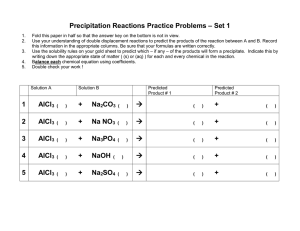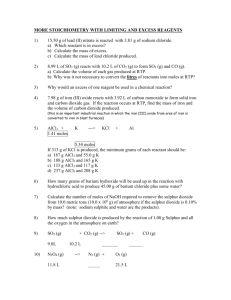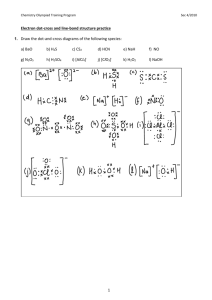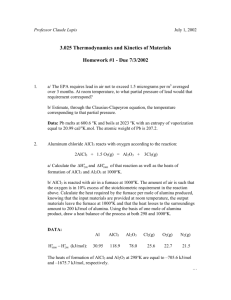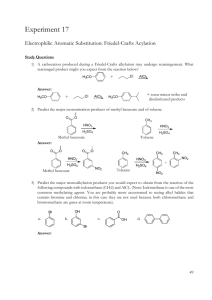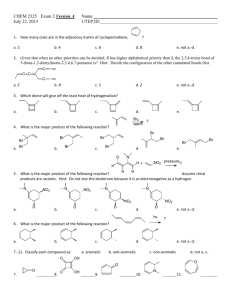Document 13310125
advertisement
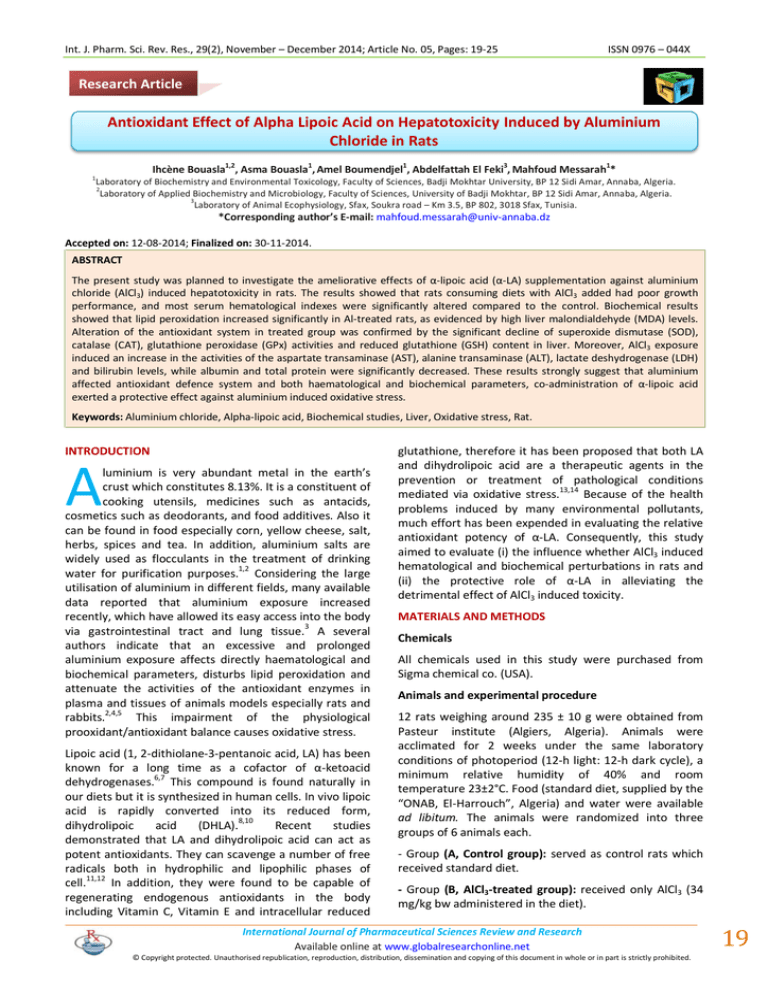
Int. J. Pharm. Sci. Rev. Res., 29(2), November – December 2014; Article No. 05, Pages: 19-25 ISSN 0976 – 044X Research Article Antioxidant Effect of Alpha Lipoic Acid on Hepatotoxicity Induced by Aluminium Chloride in Rats 1,2 1 1 1 3 1 Ihcène Bouasla , Asma Bouasla , Amel Boumendjel , Abdelfattah El Feki , Mahfoud Messarah * Laboratory of Biochemistry and Environmental Toxicology, Faculty of Sciences, Badji Mokhtar University, BP 12 Sidi Amar, Annaba, Algeria. 2 Laboratory of Applied Biochemistry and Microbiology, Faculty of Sciences, University of Badji Mokhtar, BP 12 Sidi Amar, Annaba, Algeria. 3 Laboratory of Animal Ecophysiology, Sfax, Soukra road – Km 3.5, BP 802, 3018 Sfax, Tunisia. *Corresponding author’s E-mail: mahfoud.messarah@univ-annaba.dz Accepted on: 12-08-2014; Finalized on: 30-11-2014. ABSTRACT The present study was planned to investigate the ameliorative effects of α-lipoic acid (α-LA) supplementation against aluminium chloride (AlCl3) induced hepatotoxicity in rats. The results showed that rats consuming diets with AlCl3 added had poor growth performance, and most serum hematological indexes were significantly altered compared to the control. Biochemical results showed that lipid peroxidation increased significantly in Al-treated rats, as evidenced by high liver malondialdehyde (MDA) levels. Alteration of the antioxidant system in treated group was confirmed by the significant decline of superoxide dismutase (SOD), catalase (CAT), glutathione peroxidase (GPx) activities and reduced glutathione (GSH) content in liver. Moreover, AlCl3 exposure induced an increase in the activities of the aspartate transaminase (AST), alanine transaminase (ALT), lactate deshydrogenase (LDH) and bilirubin levels, while albumin and total protein were significantly decreased. These results strongly suggest that aluminium affected antioxidant defence system and both haematological and biochemical parameters, co-administration of α-lipoic acid exerted a protective effect against aluminium induced oxidative stress. Keywords: Aluminium chloride, Alpha-lipoic acid, Biochemical studies, Liver, Oxidative stress, Rat. INTRODUCTION A luminium is very abundant metal in the earth’s crust which constitutes 8.13%. It is a constituent of cooking utensils, medicines such as antacids, cosmetics such as deodorants, and food additives. Also it can be found in food especially corn, yellow cheese, salt, herbs, spices and tea. In addition, aluminium salts are widely used as flocculants in the treatment of drinking water for purification purposes.1,2 Considering the large utilisation of aluminium in different fields, many available data reported that aluminium exposure increased recently, which have allowed its easy access into the body via gastrointestinal tract and lung tissue.3 A several authors indicate that an excessive and prolonged aluminium exposure affects directly haematological and biochemical parameters, disturbs lipid peroxidation and attenuate the activities of the antioxidant enzymes in plasma and tissues of animals models especially rats and 2,4,5 rabbits. This impairment of the physiological prooxidant/antioxidant balance causes oxidative stress. Lipoic acid (1, 2-dithiolane-3-pentanoic acid, LA) has been known for a long time as a cofactor of α-ketoacid dehydrogenases.6,7 This compound is found naturally in our diets but it is synthesized in human cells. In vivo lipoic acid is rapidly converted into its reduced form, dihydrolipoic acid (DHLA).8,10 Recent studies demonstrated that LA and dihydrolipoic acid can act as potent antioxidants. They can scavenge a number of free radicals both in hydrophilic and lipophilic phases of cell.11,12 In addition, they were found to be capable of regenerating endogenous antioxidants in the body including Vitamin C, Vitamin E and intracellular reduced glutathione, therefore it has been proposed that both LA and dihydrolipoic acid are a therapeutic agents in the prevention or treatment of pathological conditions mediated via oxidative stress.13,14 Because of the health problems induced by many environmental pollutants, much effort has been expended in evaluating the relative antioxidant potency of α-LA. Consequently, this study aimed to evaluate (i) the influence whether AlCl3 induced hematological and biochemical perturbations in rats and (ii) the protective role of α-LA in alleviating the detrimental effect of AlCl3 induced toxicity. MATERIALS AND METHODS Chemicals All chemicals used in this study were purchased from Sigma chemical co. (USA). Animals and experimental procedure 12 rats weighing around 235 ± 10 g were obtained from Pasteur institute (Algiers, Algeria). Animals were acclimated for 2 weeks under the same laboratory conditions of photoperiod (12-h light: 12-h dark cycle), a minimum relative humidity of 40% and room temperature 23±2°C. Food (standard diet, supplied by the “ONAB, El-Harrouch”, Algeria) and water were available ad libitum. The animals were randomized into three groups of 6 animals each. - Group (A, Control group): served as control rats which received standard diet. - Group (B, AlCl3-treated group): received only AlCl3 (34 mg/kg bw administered in the diet). International Journal of Pharmaceutical Sciences Review and Research Available online at www.globalresearchonline.net © Copyright protected. Unauthorised republication, reproduction, distribution, dissemination and copying of this document in whole or in part is strictly prohibited. 19 © Copyright pro Int. J. Pharm. Sci. Rev. Res., 29(2), November – December 2014; Article No. 05, Pages: 19-25 - Group (C, AlCl3+α-LA group): received both AlCl3 and αLA (35mg/kg bw) by oral gavage once per day. During all period of treatment (three weeks), food consumption was measured daily, while the body weights were recorded weekly. The amount of ingested diet was calculated as the difference between the weight of feed that remained in the food bin (D1) and the amount placed 1 day before (D2). These data were then used to calculate the daily average feed intake, according to the formula: Average feed intake: D2-D1 Quantities of AlCl3 ingested by each rat were calculated from daily food consumption. The doses of AlCl3 and α- LA 1,15-17 were selected on the basis of previous works respectively. Samples preparation Blood collection ISSN 0976 – 044X Estimation of lipid peroxidation level The lipid peroxidation (LPO) level in the liver homogenates was measured as malondialdehyde (MDA), which is the end product of lipid peroxidation, and react with TBA as a TBA reactive substance (TBARS) to produce a red colored complex which has peak absorbance at 530nm according to Buege and Aust.18 375µl of supernatant were homogenized by sonication with 150µl of PBS, 375µl of TCA-BHT (trichloroacetic acidbutylhydroxytoluene) in order to precipitate proteins and then centrifuged (1000g, 10min, 4°C). 400µl of obtained supernatant were mixed with 80µl of HCl (0.6M) and 320µl of TBA dissolved in Tris solution and the mixture was incubated at 80°C for 10 min. The absorbance of the resultant supernatant was red at 530nm.The amount of MDA was calculated by using an extinction coefficient of 1.56 x 105 mM-1cm-1. Reduced Glutathione level At the end of the experimental period, animals were weighed, overnight fasted and they sacrificed by cervical decapitation. The blood samples were immediately collected into tow ice –cold polypropylene tubes. The first one containing EDTA as anticoagulant and used for determination of haematological parameters. The second tube containing heparin as anticoagulant, which the plasma samples obtained from, by centrifugation (2200g for 15 min) after that the result supernatants were aliquoted and stored at -20°C prior to use for biochemical assay of aspartate transaminase (AST), alanine transaminase (ALT), alkaline phosphatise (ALP), lactate dehydrogenase (LDH), total bilirubin, albumin and total protein. Reduced glutathione (GSH) contents in liver and erythrocyte homogenates was estimated using a colorimetric technique, as mentioned by Ellman19, modified by Jollow et al.20, based on the development of a yellow colour when DTNB [(5, 5 dithiobis-(2nitrobenzoic acid)] was added to compounds containing sulfhydryl groups. In brief, 0.8 ml of liver supernatant was added to 0.2ml of 0.25% sulphosalycylic acid and tubes were centrifuged at 2500xg for 15min. The resulting supernatant (0.5 ml) was mixed with 0.025 ml of 0.01M DTNB and 1ml phosphate buffer (0.1M, pH 7.4). The absorbance at 412 nm was recorded. The amount of GSH was expressed as nmoles of GSH/mg protein. Antioxidant enzymes activities Preparation of liver homogenate The liver were quickly removed washed in 0.9% NaCl solution and weighed after the removal of the surrounding-connective tissues carefully, and then, one gram of liver was homogenised in 2 ml of phosphate buffer solution (PBS: 50mm Tris, 150 mm NaCl, pH 7.4) in ice cold condition. Homogenates were centrifuged at 10.000g for 15 min at 4°C, the supernatants were divided into aliquots to use each one for one time and stored at 20°C before being used. Haematological variables Haematological parameters were evaluated by electronic haematological counter (selectra coulter, Germany). Plasma biochemical markers Transaminases activities, total bilirubin, albumin and total protein levels were determined spectrophotometrically according to appropriate standardised procedures, using commercially available kits from Spinreact (Spain, refs: AST-1001 160-1001161, ALT-1001170-1001171, ALP1001130-1001131, LDH-1001260, total bilirubin 1001044, albumin -1001020-1001023, total protein 1001291). Glutathione peroxidase activity Gutathione peroxidase (GPx) (E.C.1.11.1.9) activity was measured according to the procedure of Flohe and Gunzler.21 Supernatant obtained after centrifuging 5% liver homogenate at 1500 x g for 10 min followed by 10000 x g for 30 min at 4°C was used for GPX assay. One ml of reaction mixture was prepared which contained 0.3ml of phosphate buffer (0.1M, pH7.4), 0.2ml of GSH (2mM), 0.1ml of sodium azide (10mM), 0.1ml of H2O2 (1mM) and 0.3ml of liver supernatants. After incubation at 37°c for 15min, reaction was determined by addition of 0.5ml 5% TCA. Tubes were centrifuged at 1500 x g for 5 min and the supernatant was collected. 0.2ml of phosphate buffer (0.1M pH7.4) and 0.7ml of DTNB (0.4mg/ml) were added to 0.1ml of reaction supernatant. After mixing, absorbance was recorded at 420 nm. Catalase activity The activity of catalase (CAT) (E.C.1.11.1.6) was measured according to the method of Aebi.22 The reaction mixture 1ml contained a 100mM phosphate buffer (pH 7), 500mM H2O2 and liver supernatants. The reaction started by adding H2O2 and its decomposition was monitored by following the decreased in absorbance at 240nm for 1 International Journal of Pharmaceutical Sciences Review and Research Available online at www.globalresearchonline.net © Copyright protected. Unauthorised republication, reproduction, distribution, dissemination and copying of this document in whole or in part is strictly prohibited. 20 © Copyright pro Int. J. Pharm. Sci. Rev. Res., 29(2), November – December 2014; Article No. 05, Pages: 19-25 min. The enzyme activity was calculated by using an extinction coefficient of 0.043mM-1cm-1. Superoxide dismutase activity The superoxide dismutase (SOD) (E.C.1.15.1.1) activity 23 was determined using a method of Asada et al., SOD activity was evaluated by measuring of its ability to inhibit the photo reduction of nitro-blue tetrazolium (NBT). One millilitre of homogenate’s supernatant was combined 50mM phosphate buffer (pH 7.8), 39 mM methionine, 2.6 mM NBT and 2.7 mM EDTA-Riboflavin, as to obtain a final concentration of 0.26 mM, was added as the last and switching on the light started the reaction, changes in absorbance at 560nm were recorded after 20min. In this assay, one unit of SOD is defined as the amount that inhibits the NBT reaction by 50%. Specific activity was defined as units/mg of protein. Protein content Protein supernatants concentration in liver was measured spectrophotometrically at 595 nm according to the method of Bradford24, using bovine serum albumin as standard. Statistical analysis All data are expressed as mean ± SD for six rats in each group. Significant differences between the group’s means were determined by paired student’s test. The statistical signification of difference was taken as p≤0.05. RESULTS Effects of treatments on body and relative liver weights Changes in total body weight and liver relative’s weights are shown in Table1. The total body weight showed a pronounced reduction by 20.09% and 16.068% in rats of AlCl3 treated group compared to the AlCl3+α-LA treated group and to the controls respectively. Besides, a highly significant increase in liver relative weights of AlCl3 treated rats (a hypertrophy of the liver) was noted compared to the AlCl3+ α-LA treated rats and to the controls ones. Table 1: Changes in body weight (g) and liver relative weights (g/100g bw) of control and treated rats ISSN 0976 – 044X Effects of treatments on food intake The decrease in body weight was associated with a reduction in food intake by 10.867% and 12.010% in AlCl3 treated group compared to AlCl3+ α-LA group and to the control respectively (Table 2). Table 2: Daily food intake and AlCl3 ingested of control and treated rats Parameters and treatments Control AlCl3 Food intake (g/day/rat) 21.14±2.26 18.601±4*** Quantities of AlCl3 ingested (mg/day/rat) - 6.324±1.35 AlCl3+ α-LA ### 20.87±2.31 7.1±1.35 Values are given as mean ± SD for groups of 6 animals each. Significant difference; All treated groups compared to the controls one (***p≤0.001); AlCl3 + α-LA group compared to the ### AlCl3 treated one ( p≤0.001). Effects of treatments on haematological parameters As shown in Table 3, hematological parameters in control and treated groups. Red blood cell (RBC), haemoglobin (Hb) content and mean corpuscular haemoglobin concentration (MCHC) in AlCl3 treated group were significantly decreased compared to those in the controls. While, white blood cell number (WBC) were significantly increased than those of the controls. There was no significant effect of adding 34 mg/kg AlCl3 on all haematological indexes in rats treated with AlCl3+ α-LA compared control rats. Table 3: Changes on haematological parameters of control and treated rats Parameters and treatments Control AlCl3 AlCl3+ α-LA 6 8.96±0.31 7.26±0.32* 8.80±0.50 3 10.31±1.81 13.01±0.72* 11.58±1.12 RBC (10 /µl) WBC (10 /µl) # # ## Hb (g/dl) 14.81±0.58 12.18±0.53** HT (%) 44.55±1.33 43.6±1.50 14.28±0.57 43.85±1.78 MCV 3 (mm /RBC) 49.66±1.75 49.33±2.16 49.16±1.47 Parameters studied Control AlCl3 AlCl3+ α-LA 16.55±0.69 16.30±0.62 16.58±0.39 Initial body weight (g) 236.33 ± 51.34 TCMH (pg/RBC) 242.67 ± 41.63 243.17±29.74 MCHC (g/dl) 33.26±0.46 31.56±0.60** 33.21±0.62 Final body weight (g) 311.17 ± 54.61 261.17 ± 38.20* PLT (10 /µl) 721.66±7.99 688.00±7.11 701.83±2.19 326.5±46.85 VMP 9.50±0.43 9.40±0.42 9.73±0.46 Relative liver weight (g/100g bw) 2.63 ± 0.16 3.423 ± 0.48** 2.68±0.22 3 # # Values are given as mean ± SD for groups of 6 animals each. Significant difference; All treated groups compared to the controls one (*p≤0.05, **p≤0.01); AlCl3 + α-LA group compared # to the AlCl3 treated one ( p≤0.05). # Values are given as mean ± SD for groups of 6 animals each. Significant difference; All treated groups compared to the controls one (*p≤0.05, **p≤0.01); AlCl3 + α-LA group compared # ## to the AlCl3 treated one ( p≤0.05, p≤0.05). Effects of treatments on plasma biochemical markers Table 4 showed some biochemical indexes which indicated liver injury in rats. AlCl3 treated rats data International Journal of Pharmaceutical Sciences Review and Research Available online at www.globalresearchonline.net © Copyright protected. Unauthorised republication, reproduction, distribution, dissemination and copying of this document in whole or in part is strictly prohibited. 21 © Copyright pro Int. J. Pharm. Sci. Rev. Res., 29(2), November – December 2014; Article No. 05, Pages: 19-25 Table 4: Effects of treatments on some biochemical parameters in plasma of control and treated rats Parameters and treatments Control AlCl3 AST (U/L) 152.71±4.72 296.571±1.88** 197.32±7.32 ALT (U/L) 162.368±3.94 209.506±5.67* 144.49±10.24 AlCl3+ α-LA ### ### ALP (U/L) 113.253±2.14 177.478±8.09*** 117.68±1.17 704.833±5.44 964.5±5.97*** 882.66±4.62 Total bilirubin (mg/l) 1.6±0.01 2.05±0.28* 1.683±0.01 ## Albumin (g/dl) 43.09±3.20 31.195±7.14** 43.77±2.02 ## Total protein (g/dl) 92.69±4.12 82.266±5.93 ** 85.06±5.55 Values are given as mean ± SD for groups of 6 animals each. Significant difference; All treated groups compared to the controls one (*p≤0.05, **p≤0.01, ***p≤0.001); AlCl3 + α-LA ## ### group compared to the AlCl3 treated one ( p≤0.05, p≤0.001). Effects of treatments on lipid peroxidation MDA levels in liver tissue (Figure 1) were increased in AlCl3-treated group compared to those of AlCl3+α-LAtreated group (12%) and the control (21%) ones. AlCl3+αLA-treated rats did not show any significant changes in liver MDA level compared to the control. Liver MDAlevel (nmol/mg de prot) 100 90 80 70 60 50 40 30 20 10 0 (##) (**) T AlCl3 Treatment AlCl3+α-LA ### LDH (U/L) ** compared to those of AlCl3+α-LA-treated group (14%) and the control (22%) ones. Liver GSH level (nmol/mg de prot) showed a significant increase in plasma AST, ALT, ALP, LDH and total bilirubin by 94%, 29%, 56%, 37%, and 28% respectively compared with control group and then by 50%, 45%, 50% and 22% compared to those of AlCl3+α-LA treated group, while albumin and total protein were decreased in AlCl3 treated group by 27% and 11% compared to the control one and by 28.734% and 3.28% compared to the AlCl3+α-LA group. ISSN 0976 – 044X Figure 2: Liver homogenate reduced glutathione (nmol/mg protein) levels of control and treated rats. Values are given as mean±SD for groups of 6 animals each. Significant difference: All treated groups compared to the controls one (**p≤0 .01). AlCl3+ α-LA group compared to the AlCl3 treated one (##p≤0.01). Effects of treatments on antioxidant enzyme activities Results in Figure 3 showed Changes of GPx, SOD and CAT activities in liver tissue which indicated liver oxidative damage. Exposure rats to AlCl3 produced a significant decline in GPx, SOD and CAT enzyme activities compared to those of control group. In contrast, treatment with 35 mg/kg of α-lipoic acid resulted in a significant amelioration of 4-43% in the enzyme activities (GPx, SOD and CAT). 0,4 (**) 0,35 (#) 0,3 0,25 0,2 0,15 0,1 0,05 0 T AlCl3 AlCl3+α-LA Treatment Figure 1: Liver homogenate malondialdehyde (nmol/mg protein) levels of control and treated rats. Values are given as mean ± SD for groups of 6 animals each. Significant difference: All treated groups compared to the controls one (**p≤0 .01). AlCl3+α-LA group compared to # the AlCl3 treated one ( p≤0.05). Effects of treatments on GSH content Results in Figure 2 Showed changes of GSH levels in liver tissue which indicated liver oxidative injury. Exposure rats to AlCl3 produced a significant decline in GSH levels International Journal of Pharmaceutical Sciences Review and Research Available online at www.globalresearchonline.net © Copyright protected. Unauthorised republication, reproduction, distribution, dissemination and copying of this document in whole or in part is strictly prohibited. 22 © Copyright pro Int. J. Pharm. Sci. Rev. Res., 29(2), November – December 2014; Article No. 05, Pages: 19-25 ISSN 0976 – 044X absorption of AlCl3 in the intestine. It can also be suggested that both α-LA and DHLA chelate heavy metals, restricts the molecular damage and reduce hepatic injury. Figure 3: Liver homogenate glutathione peroxidase (nmoles of GSH/min/mg protein), superoxide dismutase (U/mg de protein) and catalase (µmoles H2O2/min/mg protein) activities of control and treated rats. Values are given as mean ± SD for groups of 6 animals each. Significant difference: All treated groups compared to the controls one (*p≤0.05), (**p≤0 .01), (***p≤0.001). AlCl3+ # α-LA group compared to the AlCl3 treated one ( p≤0.05), ## ( p≤0.01). DISCUSSION In our experimental study, reduction in body weight is used as an indicator for the deterioration of rat general health status. It has been reported that AlCl3 could induce toxicological effects and biochemical dysfunctions representing serious health hazards.2,25,26 The findings from the present work indicate that excessive AlCl3 exposure has changed body weight, absolute and relative liver weights, leading however to significant decrease in animal growth and production performances. This could be probably attributed to the reduction of feed consumption and/or malabsorption of nutrients induced by AlCl3 effects on the gastro-intestinal tract and/or inhibition of protein synthesis.2,25,26 AlCl3 exposure may account to reduced food intake seen in the AlCl3-treated group. Hence, these findings were similar to the results 1,26 published by El-Demerdash, and Zhu et al. who reported that high Al exposure have significantly induced disturbances of the total body weight, absolute and relative liver weights of rats. Accordingly, among the main approaches used to ameliorate Al-induced hepatotoxicity is the use of agents with powerful antioxidant properties. However, recent studies have reported that lipoic acid showed significant protective effects against tissue damage induced by some xenobiotics like arsenic8,27, Bisphenol A28 and adriamycin.17 The co-administration of lipoic acid attenuated the in vivo effects of AlCl3 by scavenging or neutralizing ROS. These results indicated that α-LA might have a beneficial role in lowering AlCl3 toxicity probably due to its radical scavenging property. Thus, α-LA treatment corrects the body weight slow-down and the relative liver weight increases. This may be attributed to an increases food intake and /or lipoic acid capability to interfere with the Exposure rats to AlCl3 decreased hematological parameters (RBCs and Hb) and developed anemia in rats. Our experimental were in line with previous reports which demonstrated that heavy metals exposure altered hematological parameters in rats29,30 In fact, according to the earlier reports29,31,32 this anaemia could be explained by the inhibition of erythropoiesis and/or haemoglobin synthesis reduction, the same reports indicate that AlCl3 could be interfering with Fe incorporation to the heme group witch induce Fe deficiency and reduce heme synthesis. Also the observed microcytic anaemia it might be due to an increase in the rate of erythrocytes destruction in haematopoietic organs. So, AlCl3 might be crossing the erythrocyte membrane which is a result of its 2,5,30 ability to initiate a lipid peroxidation. In our study, AlCl3-treated rats also exhibited significantly higher WBC compared with controls rats. This increase might be indicative of the activation of defence and immune system showed that there were oedema and inflammation in the tissues.5 The results of the present study showed that α-LA supplementation has potentially beneficial effects on haematological system. Our results are similar to a previous studies reported by Caylak et al.33 In fact, this beneficial effect are probably due to the direct chelating activity of α-LA which have possibility to decrease the AlCl3 concentration in blood cells and inhibit its entry into erythrocytes, resulting an increase of Fe and facilitate its incorporation to the hem group. It could be also related to the anti-inflammatory effects of α-LA reported in several prior studies.11,34 The disturbance in the transport function of the hepatocytes as a result of hepatic injury causes the leakage of enzymes from the liver cytosol into the blood due to altered permeability of membrane. In this work, AlCl3-treated rats showed a significant increase in plasma levels AST, ALT, ALP and LDH, which confirmed the liver injury or dysfunction these results are in line with that 1 15 reported by El-Demerdash and Gaskill et al. Also, increases enzymes plasma levels may be due to the disturbance in the balance between biosynthesis and degradation of these enzymes.35,36 Additional effects of AlCl3 treatment revealed decreased plasma total protein, albumin and increased total bilirubin as compared to control. This data are in agreement with previous studies.15,36 So, the significant decrease in the concentration of the albumin could be attributed on the one hand to an under nutrition and on the other hand to a reduction of the protein synthesis in the liver results a decreasing plasma total protein which confirmed the 2,36 direct damaging effect of AlCl3 on liver cells. The increase in plasma total bilirubin may result from decreased liver uptake, conjugation or increased bilirubin production from haemolyse. El-Sharaky et al.37 found that International Journal of Pharmaceutical Sciences Review and Research Available online at www.globalresearchonline.net © Copyright protected. Unauthorised republication, reproduction, distribution, dissemination and copying of this document in whole or in part is strictly prohibited. 23 © Copyright pro Int. J. Pharm. Sci. Rev. Res., 29(2), November – December 2014; Article No. 05, Pages: 19-25 the induction rat in bilirubin was associated with free radical production. On the other hand, lipoic acid prevent the increase in the activities of these enzymes is the primary evidence of 7 their hepatoprotective activity. In the present finding, lipoic acid co-administration produced an effective action against the hepatocytes damaging effects, as shown by a decrease of the elevated plasma hepatic key enzymes (AST, ALT, ALP and LDH) and by a normalisation of albumin, total protein and total bilirubin. The mechanism proposed to explain these results could be attributed to α-LA preventive effects against AlCl3 induced damages in 7,14 rats hypatocytes. So, the α-LA prevents cellular necrosis as well as the membrane failure, this hepatoprotective effects might be related to both its radical scavenging proprieties and indirect effect as a regulator of antioxidative systems.16, 17, 25 The increased level of MDA in AlCl3 treated rats could be linked to the peroxidation damages of biological membranes, caused by an increased reactive Fe+2.38,39 According to Newairy et al.,15 and Wu et al.39 study’s, aluminium is able to be bound by the Fe+3carying transferrin protein because of most closely Al+3 ionic radical resemble those of Fe+3, results an accumulation of Fe+2 in cells. Besides1,38 reported that an increased MDA concentration could be caused by inactivation of enzymes involved in antioxidant system such as GPx, SOD and CAT activities. In fact, AlCl3 accumulation induced alteration of zinc and copper homeostasis and decreasing its binding ability to the antioxidant enzymes which caused antioxidant enzymes dysfunction. The decreasing GSH activity might be related to the inhibitor AlCl3 effect on Glutamyl-cysteine-synthetase activity, the enzyme that controls the biosynthesis of glutathione in liver, thus resulting a reduction in GSH synthesis. This might be coupled to the aluminium inhibiting ability of NADPHgenerating enzymes such as glucose 6-phosphate dehydrogenase and NADP-isocitrate dehydrogenase, resulting a slowing down in the GSH regeneration.15 Oxidative stress occurred as a consequence of imbalance between the production of reactive oxygen species and the antioxidative process in favor of radical production. In the current study, the significant decrease in the antioxidant enzyme activities (GPx, SOD and CAT) in liver proved the failure of antioxidant defense system to overcome the influx of reactive oxygen species generated by Al exposure. α-LA supplementation produced protective effect against antioxidant defense system failure our result is in agreement with data reported from 8,28 similar studies on rats. This study suggested that α-LA antioxidants capacity may be due to its ability to chelate both heavy and transition metals, to scavenge reactive oxygen species by the sulphydryl group to regenerate endogenous antioxidants (such as vitamin C, vitamin E, and GSH) and to repair oxidative damage of cellular macromolecules which prevent the increase in lipid peroxidation level and increasing the antioxidants enzymes activities. Several reports8,9,14 evidenced that a ISSN 0976 – 044X combination of α-LA could prevent GSH depletion by scavenging reactive oxygen species and /or increasing cysteine uptake, which is a rate limiting step for GSH biosynthesis. CONCLUSION This study clearly indicates that AlCl3 affects both haematological and biochemical parameters as well as antioxidative system inducing oxidative stress. Coadministration of α-LA ameliorates this disturbance. In fact, the ameliorative effect of α-LA against oxidative stress in AlCl3 treated rats due to its antioxidant propriety by scavenging free radical and chelating metals as well as regeneration of endogenous antioxidant. Nevertheless, further studies are needed to investigate the precise mechanism(s) of action of α-LA on oxidative stress biomarkers in rat under AlCl3 intoxication. Acknowledgments: The present research was supported by the Algerian Ministry of Higher Education and Scientific Research, Directorate General for Scientific Research and Technological Development through the Research Laboratory of “Laboratory of Biochemical and Environmental Toxicology” Faculty of Sciences, Badji Mokhtar University, Annaba, Algeria REFERENCES 1. El-Demerdash FM, Antioxidant effect of vitamin E and selenium on lipid peroxidation, enzyme activities and biochemical parameters in rats exposed to aluminium, Trace elements in medicine, 18, 2004, 113-121. 2. Lukyanenko LM, Skarabahatava AS, Slobozhanina EI, Kovaliova SA, Falcioni ML, In vitro effect of AlCl3 on human erythrocytes: changes in membrane morphology and functionality, J Trace Elem Med Biol, 27, 2013, 160-167. 3. Prakash A, Kumar A, Effect of N-acetyl cystein against aluminium induced cognitive dysfunction and oxidative damage in rats, Basic Clin Pharmacol Toxicol, 105, 2009, 98104. 4. Guo C, Hsu GW, Chuang C, Chen P, Aluminium accumulation induced testicular oxidative stress and altered selenium metabolism in mice, Environl Toxicol Pharmacol, 27, 2009, 176181. 5. Mahdy KA, Farrag ARH, Amelioration of aluminium toxicity with black seed supplement on rats, Toxicol Environ Chem, 91, 2009, 567-579. 6. Ghibu S, Richard C, Delemasure S, Vergely C, Mogosan C, Muresan A, An endogenous dithiol with antioxidant properties: Alpha-lipoic acid, potential uses in cardiovascular diseases, Anal Card Angéiol, 57, 2008, 161-165. 7. Saad EI, El-Gowilly SM, Sherhaa MO, Bistawroos AE, Role of oxidative stress and nitric oxide in the protective effects of α-lipoic acid and aminoguanidine against isoniazid-rifampicininduced hepatotoxicity in rats, Food Chem Toxicol, 48, 2010, 1869-1875. 8. Kokilavani V, Devi Ma, Sivarajan K, Panneerselvan C, Combined efficacies of DL- α-lipoic acid and meso 2,3 dimercaptosuccinic acid against arsenic induced toxicity in antioxidant systems of rats, Toxicol Lett, 160, 2005, 1-7. International Journal of Pharmaceutical Sciences Review and Research Available online at www.globalresearchonline.net © Copyright protected. Unauthorised republication, reproduction, distribution, dissemination and copying of this document in whole or in part is strictly prohibited. 24 © Copyright pro Int. J. Pharm. Sci. Rev. Res., 29(2), November – December 2014; Article No. 05, Pages: 19-25 ISSN 0976 – 044X 9. Winiarska K, Malinska D, Szymanski K, Dudziak M, Bryle J, Lipoic acid ameliorates oxidative stress and renal injury in alloxan diabetic rabbits, Biochim, 90, 2008, 450-459. 26. Zhu Y, Li X, Chen C, Wang F, Li J, Hu C, Li Y, Miao L, Effects of aluminium trichloride on the trace elements and cytokines in the spleen of rats, Food Chem Toxicol, 50, 2012, 2911-2915. 10. Moraes TB, Zanin F, Rosa AD, Oliveira AD, Coelho J, Petrillo F, Wajner M, Dutrafilho CS, Lipoic acid prevents oxidative stress in vitro and in vivo by an acute hyper phenylalaninemia chemically-induced in rat brain. Neur Sci, 292, 2010, 89-95. 27. Shila S, Kokilavani V, Subathra M, Panneerselvam C, Brain regional responses in antioxidant system to α-lipoic acid in arsenic intoxicated rat, Toxicology, 210, 2005, 25-36. 28. 11. Navari-Izzo F, Quartacci MF, Sgherri C, Lipoic acid: a unique antioxidant in the detoxification of activated oxygen species, Plant Physio Biochem, 40, 2002, 463-470. El-Beshbishy HA, Aly HAA, El-Shafey M, Lipoic acid mitigates bisphenol A-induced testicular mitochondrial toxicity in rats, Toxicol Ind health, 29, 2012, 875-887. 29. 12. Yi X, Nickeleit V, James LR, Maeda N, α-lipoic acid protects diabetic apolipoprotein E- deficienr mice from nefropathy, Diab Compl, 25, 2011, 193-201. Flora SJS, Mehta A, Satsangi K, Kannan GM, Gupta M, Aluminium induced oxidative stress in rat brain response to combined administration of citric acid and HEDTA, Comp Biochem Physiol, 134, 2003, 319-328. 13. Ganapthay A, Anthony J, Vartharjan S, Protective effect of lipoic acid on oxidative damage in cyclosporine A-inducing renal toxicity, Int Immunopharmacol, 7, 2007, 1442-1449. 30. Farina M, Ratta LN, Soares FAA, Jardim F, Jacques R, Souza DO, Rocha JBT, Haematological changes in rats chronically exposed to oral aluminium, Toxicology, 209, 2005, 29-37. 14. Abdel-Zaher A, Abdel-Hady RH, Mahmoud MM, Farrag MMY, The potential role of alpha-lipoic acid against acetaminopheninduced hepatic and renal damage, Toxicology, 243, 2008, 261270. 31. 15. Newairy AL-SA, Salama AF, Hussien Hm, Yousef MI, Propolis alleviates aluminium induced lipid peroxidation and biochemical parameters in male rats, Food Chem Toxicol, 47, 2009, 1093-1098. Mahieu S, Millen N, Gonzelez M, Contini MDC, Elias MM, Alteration of the renal function and oxidative stress in renal tissue from rats chronically treated with aluminium during the initial phase of hepatic regeneration, J Inorg Biochem, 99, 2005, 1858-1864. 32. Shrivastava S, Combined effect of HEDTA and selenium against aluminium induced oxidative stress in rat brain, J Trace Elem Med Biol, 26, 2012, 210-214. 33. Caylak E, Aytekin M, Halifeoglu I, Antioxidant effects of methionine, α-lipoic acid, N-acetylcysteine and homocysteine on lead-induced oxidative stress to erythrocytes in rats, Exp Toxicol Path, 60, 2007, 289-294. 34. Shay KP, Mareau RF, Smith EJ, Smith AR, Hagen TM, Alphalipoic acid as a dietary supplement: Molecular mechanisms and therapeutic potential, Biochim Biophys Acta, 1790, 2009, 11491160. 35. Gaskill CL, Miller LM, Mattoon JS, Hoffman WE, Burton SA, Gelens HCJ, Ihle SL, Miller JB, Shaw DH, Cribb AE, Liver histopathology and liver serum alanine aminotransferase and alkaline phosphatase activities in epileptic dogs receiving phenobarbital, Vet Pathol, 42, 2005, 147-160. 36. Yousef MI, Kamel IK, Esmail AM, Baghdadi HH, Activities and lipid lowering effects of isoflavone in mal rabbits, Food Chem Toxicol, 42, 2004, 1497-1503. 37. El-Sharaky AS, Newairy AA, Badreldeen MM, Eweda SM, Sheweita SA, Protective role of selenium against renal toxicity induced by cadmium in rats, Toxicology, 235, 2007, 185-193. 16. Malarkodi KP, Varalakshmi P, Lipoic acid as rescue agent for adriamycin-induced hyperlipidemie nephropathy in rats, Nut Res, 23, 2003, 539-548. 17. Prahalathan C, Selvakumar E,Varalakshmi P, Role of lipoic acid on adriamycin-induced testicular injury, Chem Biol Int 160, 2006, 108-114. 18. Buege JA, Aust SD, Microsomal lipid peroxidation, Methods enzymol, 105, 1984, 302-310. 19. Ellman GL, Tissue sulphydryl groups, Arch Biochem Biophys, 82, 1959, 70-77. 20. Jollow DJ, Mitchel JR, Zamppaglione Z, Gillette JR, Bromobenzene induced liver necrosis. Protective role of glutathione and evidence for 3,4-bromobenzene oxide as the hepatotoxic metabolites, Pharmacology, 11, 1974, 51-57. 21. Flohe L, Gunzler WA, Analysis of glutathione peroxidase, Methods Enzymol, 105, 1984, 114-121. 22. Aebi H, Catalase in vitro, Method Enzymol, 105, 1984, 121– 126. 23. Asada K, Takahashi M, Nagate M, Assay and inhibitors of spinach superoxide dismutase, Agric Biol Chem, 38, 1974, 471473. 38. Nehru B, Anand P, Oxidative damage following chronic aluminium exposure in adult and pup rat brains, Trace Elem Med and Biol, 19, 2005, 203208. 24. Bradford M, A rapid and sensitive method for the quantities of microgram quantities of protein utilizing the principle of protein binding, Anal Biochem, 72, 1976, 248-254. 39. 25. Koizumi MH, Fujii S, Ono A, Hirose A, Imai T, Ogawa K, Ema M, Nishikawa A, Two generation reproductive toxicity study of aluminium sulphate in rats, Reprod Toxicol, 31, 2010, 219-230. Wu Z, Du Y, Xue H, Wu Y, Zhou B, Aluminium induces neuro degeneration and its toxicity arises from increased iron accumulation and reactive oxygen species (ROS) production, Neurobiol Aging, 33, 2012, 1-12. Source of Support: Nil, Conflict of Interest: None. International Journal of Pharmaceutical Sciences Review and Research Available online at www.globalresearchonline.net © Copyright protected. Unauthorised republication, reproduction, distribution, dissemination and copying of this document in whole or in part is strictly prohibited. 25 © Copyright pro
